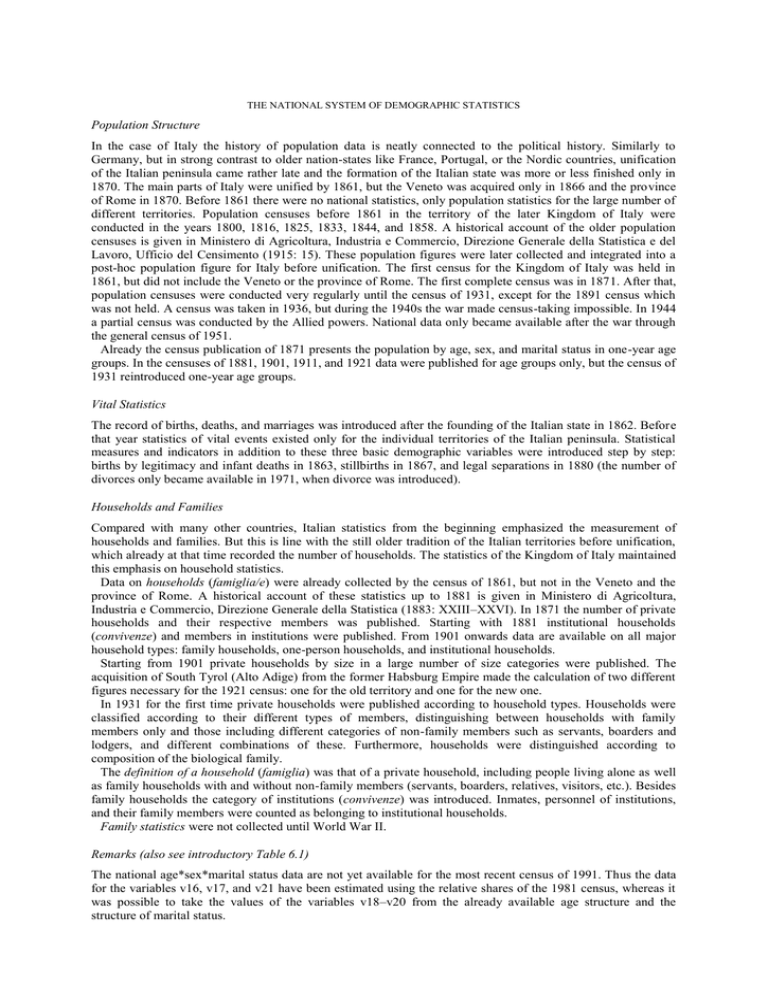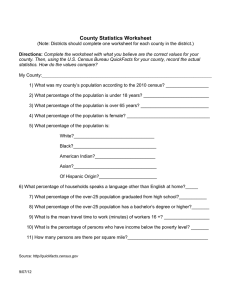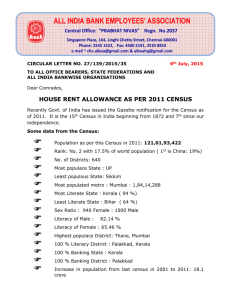i8.doc
advertisement

THE NATIONAL SYSTEM OF DEMOGRAPHIC STATISTICS Population Structure In the case of Italy the history of population data is neatly connected to the political history. Similarly to Germany, but in strong contrast to older nation-states like France, Portugal, or the Nordic countries, unification of the Italian peninsula came rather late and the formation of the Italian state was more or less finished only in 1870. The main parts of Italy were unified by 1861, but the Veneto was acquired only in 1866 and the province of Rome in 1870. Before 1861 there were no national statistics, only population statistics for the large number of different territories. Population censuses before 1861 in the territory of the later Kingdom of Italy were conducted in the years 1800, 1816, 1825, 1833, 1844, and 1858. A historical account of the older population censuses is given in Ministero di Agricoltura, Industria e Commercio, Direzione Generale della Statistica e del Lavoro, Ufficio del Censimento (1915: 15). These population figures were later collected and integrated into a post-hoc population figure for Italy before unification. The first census for the Kingdom of Italy was held in 1861, but did not include the Veneto or the province of Rome. The first complete census was in 1871. After that, population censuses were conducted very regularly until the census of 1931, except for the 1891 census which was not held. A census was taken in 1936, but during the 1940s the war made census-taking impossible. In 1944 a partial census was conducted by the Allied powers. National data only became available after the war through the general census of 1951. Already the census publication of 1871 presents the population by age, sex, and marital status in one-year age groups. In the censuses of 1881, 1901, 1911, and 1921 data were published for age groups only, but the census of 1931 reintroduced one-year age groups. Vital Statistics The record of births, deaths, and marriages was introduced after the founding of the Italian state in 1862. Before that year statistics of vital events existed only for the individual territories of the Italian peninsula. Statistical measures and indicators in addition to these three basic demographic variables were introduced step by step: births by legitimacy and infant deaths in 1863, stillbirths in 1867, and legal separations in 1880 (the number of divorces only became available in 1971, when divorce was introduced). Households and Families Compared with many other countries, Italian statistics from the beginning emphasized the measurement of households and families. But this is line with the still older tradition of the Italian territories before unification, which already at that time recorded the number of households. The statistics of the Kingdom of Italy maintained this emphasis on household statistics. Data on households (famiglia/e) were already collected by the census of 1861, but not in the Veneto and the province of Rome. A historical account of these statistics up to 1881 is given in Ministero di Agricoltura, Industria e Commercio, Direzione Generale della Statistica (1883: XXIII–XXVI). In 1871 the number of private households and their respective members was published. Starting with 1881 institutional households (convivenze) and members in institutions were published. From 1901 onwards data are available on all major household types: family households, one-person households, and institutional households. Starting from 1901 private households by size in a large number of size categories were published. The acquisition of South Tyrol (Alto Adige) from the former Habsburg Empire made the calculation of two different figures necessary for the 1921 census: one for the old territory and one for the new one. In 1931 for the first time private households were published according to household types. Households were classified according to their different types of members, distinguishing between households with family members only and those including different categories of non-family members such as servants, boarders and lodgers, and different combinations of these. Furthermore, households were distinguished according to composition of the biological family. The definition of a household (famiglia) was that of a private household, including people living alone as well as family households with and without non-family members (servants, boarders, relatives, visitors, etc.). Besides family households the category of institutions (convivenze) was introduced. Inmates, personnel of institutions, and their family members were counted as belonging to institutional households. Family statistics were not collected until World War II. Remarks (also see introductory Table 6.1) The national age*sex*marital status data are not yet available for the most recent census of 1991. Thus the data for the variables v16, v17, and v21 have been estimated using the relative shares of the 1981 census, whereas it was possible to take the values of the variables v18–v20 from the already available age structure and the structure of marital status.





